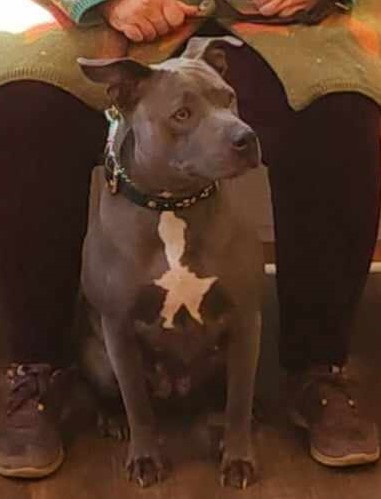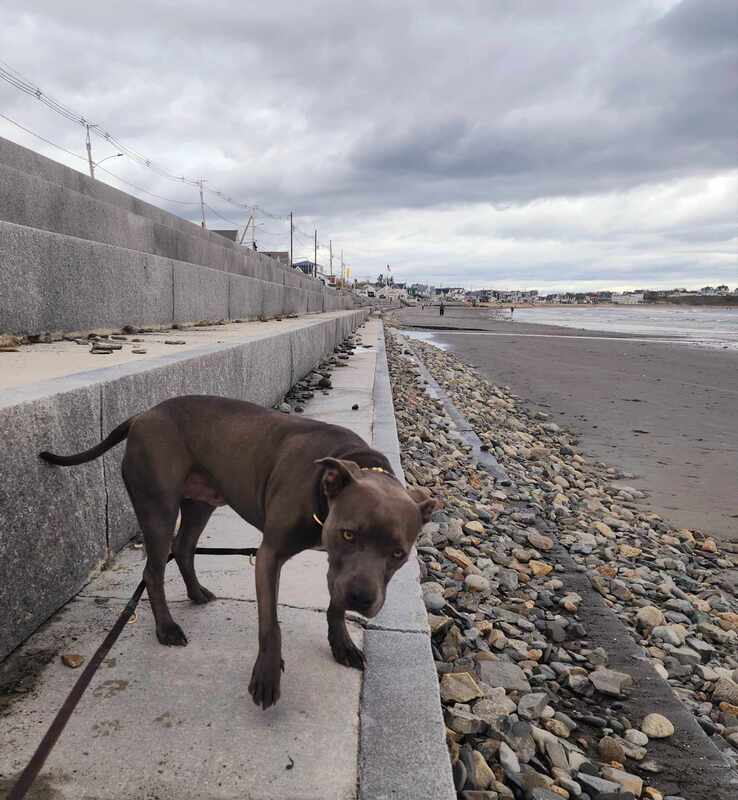| At the beginning of Week 9, I made sure to do a lot of videos. I hope to string these together someday, to show the progress that is made over time. Alas, I am a much better dog trainer than "digital creator'. Perhaps some more practice will make perfect. We were mostly inside this week, as I had a lot of client dogs over needing to be trained, and I was pooped by 6 pm. This weekend, we are going to do a lot of "on the road training"m as I have am even busier week coming up next week. LaLa does help out on occasion by being the distraction in a crate for private lessons. In day training, she is a moving distraction. |
 LaLa sitting pretty for someone else while out on errands with my husband. LaLa sitting pretty for someone else while out on errands with my husband. Markers and Feedback are used in most of my training. Markers used for feedback give your dog additional information to your tone, body movements, and verbal cues used for commands. Feedback is information that lets your dog know whether they are on the right track or not, depending on what you are doing with them. It is important that feedback is given at a well-timed point to let them know in that moment if they are performing or working in the direction or task that you want. Ideally you want this feedback to be able to be given with some space in between you once you get going. Rewards and corrections are a type of feedback that is close up. Instead in this article, I am going to talk about equipment, the clicker, and verbal, your voice. LaLa is probably being told she is a "good girl" when sitting pretty for a stranger above. Good is a marker for "Good Job and Keep Going".
Anyway, LaLa and I have been working, and here are some videos that show some of our progress below:
Week 5 LaLa Training Blog: More Exposure to Outside Distractions and Dropping the Leash Inside6/2/2024
 Training my own new dog, Laurel/LaLa, comes with it's own doubts. This is especially true when you have not had a new dog for 11 years. Luckily though, I am a dog trainer and do this with client dog's that I am getting to know all the time. I do have a basic format for my training, although it can change with individual dogs. On our first week, I did have some time (as I was on vacation for some of it) to do two hour days. So that is never training two hours in a row (except maybe in the future on walks, as the dog does not really know they are training and are jazzed up to be out). The longest times are behavioral or calming exercises which generally last for 15-30 minutes plus. Then obedience exercises may be sprinkled through the day from 5-15 minute sessions, depending on what we are working on. I include play training as obedience sessions as that is what I am working towards, even if we are not at the obedience part at first. Although, while LaLa likes to play, she is not really interested in balls, frisbees, or flirt poles towards that purpose at the moment. Maybe she will grow into that. |
Author, Robin RubinOwner and Head Dog Trainer in Maine, Robin Katherine Rubin, started her Maine dog training business in September 2004. Our dog training facility is located in Southern Maine in York Beach and we help families enjoy their dogs more, making sure they listen reliably and resolving unwanted behaviors. Archives
July 2024
Categories
All
|







 RSS Feed
RSS Feed